"Lion", "Mosquito" and "Moray"
A serious blow to the further improvement of naval artillery after World War II was dealt by the rapid development of rocket weapons. In 1967, in a matter of minutes, the Israeli destroyer Eilat was easily sunk by two Egyptian missile boats (Soviet-made Komar class). This became a worldwide sensation and caused excessive euphoria among politicians and admirals. It seemed a few more years - and the artillery cannons could only be used for holiday fireworks. In addition, several years earlier, the then Soviet leader Nikita Sergeevich Khrushchev put an end to several types of Soviet ships, which had artillery as their main means. By Khrushchev's decision in 1950's, all work on ship guns of a caliber over 76 millimeters was stopped, and for almost two decades naval artillery systems of medium and large caliber were not developed in Russia.
However, local conflicts of the 1950s and 1960s showed that it is too early to write off the guns ashore. For example, during the war in Korea, the 406-mm Iowa-class battleship guns became the most effective of all the artillery systems used by the US forces. The high combat potential of these guns was also manifested during the Vietnam War, and foreign experts compared the fire of the battleship New Jersey with the power of bombing attacks of 50 aircraft simultaneously. The US Navy command, evaluating the actions of its steel giants, considered that their ability to operate in almost any weather conditions, the high accuracy and effectiveness of fire to defeat protected targets put the battleship in first place in comparison with field artillery, bomber and assault aviation. And in 1975 in the USA after an 11-year hiatus in the construction of destroyers fleet includes the first ship of this class, but of a new generation. The Springs, the main caliber of which included two 127-mm Mk45 single-gun gun mounts with a firing range of about 24 kilometers, became an important stage in the world military shipbuilding and marked the beginning of a new era of naval artillery. Moreover, in the same year, the British (also after a long, 22-year hiatus) handed over to their fleet the Sheffield destroyer, armed with the Vickers 114-mm gun mount Mk8. The installation had a firing range of 20 kilometers, a rate of fire of 25 rds / min and could open fire 15 seconds after receiving the command. But largely thanks to the Spruence and Sheffield, paradoxically, the most powerful ship guns and the best destroyers of the last quarter of the twentieth century appeared: the Soviet 130-mm AK-130 complexes and project ships 956.
Six tons of metal per minute
At the end of the 1960-ies, the Leningrad design bureau Arsenal was assigned a responsible task: to create a new 130-mm naval artillery tower, the technical characteristics of which in 3 — 5 would exceed any foreign counterparts in terms of rate of fire and the number of shots ready for automatic shooting, yes and when it is possible to change the type of ammunition during rapid shooting.
It was with whom to compete. For example, Americans, realizing the enormous potential of rocket weapons, nevertheless did not stop work on ship artillery, and in 1955 they adopted the 127-mm one-gun automatic installation Mk42. The turret mass is 63 tons, the guns are 2,5 tons, the projectiles are 31,75 kilograms, and the entire shot is 48,5 kilograms. The gun was induced horizontally from –180 ° to 180 ° (40 ° / s), and vertically from –7 ° to 85 ° (25 ° / s). Practical rate of fire - 20 shots / min, the maximum firing range at the air target - 14,4 kilometers, on surface and on the coast - 21,9 kilometers. For shooting, 40 shells were constantly prepared, packed in two drums with double-sided automatic feed, the initial velocity of the projectile was 808 m / s. And in 1971, it was replaced by the advanced Mk45 artillery system - the same caliber, but with much better performance. The mass of the turret was reduced by using reinforced aluminum, and the ammunition was supplied from a drum-type shop on 20 unitary shots.
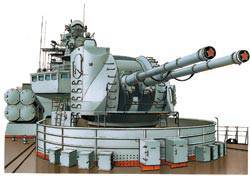 130-mm double-barreled artillery unit of the AK-130-MP-184 complex: barrel length 6990 mm, rollback length 520 — 624 mm, pointing angle: vertical from –12 ° to 80 °, horizontal from –200 ° to 200 °, pointing speed 25 ° / s, the mass of the complex with one AU without ammunition 98 t, firing range - more than 22 km
130-mm double-barreled artillery unit of the AK-130-MP-184 complex: barrel length 6990 mm, rollback length 520 — 624 mm, pointing angle: vertical from –12 ° to 80 °, horizontal from –200 ° to 200 °, pointing speed 25 ° / s, the mass of the complex with one AU without ammunition 98 t, firing range - more than 22 km A particularly difficult task for Soviet gunsmiths was the development of a rational scheme for the supply of artillery mounts with ammunition. First, it was necessary to reduce to a minimum the number of overloads of ammunition when it is automatically fed from the turret section to the line of fire. And secondly, it was necessary to ensure the safety of ammunition when moving. This problem was solved by creating a unitary cartridge of 130 caliber of millimeters for the first time in artillery practice - before the Americans did a similar cartridge. And the whole system came out unique: its originality was confirmed by 77 with copyright certificates for inventions.
This complex and the A-218 cannon, which is included in it, is still superior in its characteristics to all existing foreign ship-mounted artillery installations of a similar caliber. And when the lead destroyer of the 956 project — the first ship armed with a new weapon — entered the expanses of the World Ocean, the western naval experts were in shock. Another thing: the four barrels of the destroyer, called “Modern”, for a minute, launched into the enemy more than 6 tons of shells (!) - a record that some battleships could envy and to which neither American nor European designers could approach.
Shooting in the AK-130 is carried out using the MP-184 “Lion” radar fire control system consisting of a dual-band target tracking radar, a television, a laser rangefinder and equipment for the selection of mobile targets and jamming protection. The “Lion” can receive target designation from general-purpose detection means, perform accurate measurements of the motion parameters of air, sea and coastal targets, generate guidance angles for two gun mounts, conduct automatic correction of firing at the naval target for bursts, and also perform automatic tracking of the projectile fired. The main projectile - high-explosive fragmentation with three types of fuses - can penetrate 30-mm homogeneous armor at an angle 45 ° and explode behind it, causing maximum damage to the target. Air targets are destroyed by ZS-44 projectiles with a remote fuse DVM-60M1 and ZS-44P projectiles with a radar fuse AP-32, which provides a target hit with a miss to 8 meters when firing anti-ship missiles and 15-500-meter-500-meter airframes and XNUMXXXXXXXXXMUMMXXMUMXXXMUMMXXUMMXXUMM objects that use XNUMX and XNUMX radar fuses with AP-XNUMX radar fuse and XNUMX missiles.
In addition, AK-130 has an automatic system for reloading ammunition from the artillery cellar to the sub-unit unit: it provides the complex with the ability to fire continuously with a rate of fire up to 60 rpm, up to complete emptying of its cellars. And without any participation of the calculation. Such is the gun robot.
Tsar-gun of the XX century
The eighties of the last century became a kind of Renaissance era of ship artillery. Work on this topic was especially active in the USSR. Designers, inspired by the success in creating automatic gun mounts of 100 caliber and 130 millimeters, decided to wipe at something more. And in 1983 — 1984, a project of 406-mm smooth-bore ship-borne cannon, simultaneously designed to launch surface-to-surface and surface-to-air guided missiles, is ready. In addition, it was supposed to shoot from this “king-cannon” both with feathered projectiles and depth charges, including nuclear ones. At the same time, due to its relatively small dimensions and weight, the installation of a (turretless) type, the weight of the installation with a single-tier cellar was only 32 tons - could be placed on surface ships with a displacement of 2000 tons, that is, even on the sentry.
It was possible to exclude the tower from the design of the ship's artillery installation due to the deepening of the axle axles below the deck 0,5 meters. True, this limited the angle of elevation to the range from 30 ° to 90 °. The walls of the barrel were reduced by using howitzer ballistics. Balancing of the swinging part, located under the combat table and passing through the embrasure of the dome, was carried out using a pneumatic balancing mechanism.
Loading the implement (only at an elevation angle of 90 °) immediately from the cellar with the aid of an elevator-rammer installed from the base part. Moreover, it was allowed to quickly change the type of ammunition - in just 4 seconds and without first finishing shots on the feed and feed tracks. The shot itself consisted of a projectile (rocket) and a pallet with a propellant charge, which was the same for all types of ammunition. All operations on the submission and shipment were performed automatically.
Estimated range of 110-kilogram shells - 42 kilometers, powerful 1200-kilogram ammunition - up to 10 kilometers, and guided missiles could hit the target at ranges up to 250 kilometers. Projectiles rate of fire - 15 — 20 rds / min, rockets - 10 rds / min. Combat calculation of the installation was only 4 — 5 people. However, despite the uniqueness of the new gun, the command resolution was succinctly negative: "The caliber 406 of millimeters is not provided for by the standards of the Russian Navy."
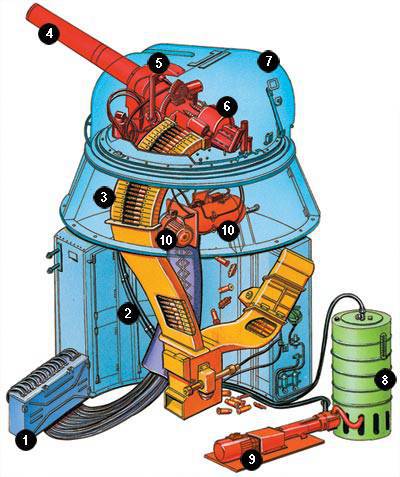
The famous "metal cutter" - 30-mm six-barrel artillery mount AK-630M. Numbers denoted by:
1. Control block
2. Cooling hoses
3. Gun feed sleeve
4. Automatic AO-18
5. Mask
6. Sleeve seal
7. Art fairing
8. Cooling system tank
9. Cooling system pump and electric motor
10. Hydraulic pumps of vertical and horizontal targeting drives
Whether a projectile, or a rocket
The further development of the ship's artillery was hampered by an objective reason: the traditional projectile represents, strictly speaking, a “pig”, which must be thrown as far as possible. But after all, the powder charge is limited in mass and strength, so the designers found an original way out - they created a rocket projectile that combines the advantages of a conventional projectile, which is almost impossible to shoot down, and rockets, whose jet engine allows it to fly long range.
Americans were the first to use such a projectile first in the ship’s artillery - in the 127-mm artillery unit Mk45, the drum magazine of which could take instead of the 20 conventional unitary shots 10 of separate-loading shots with Dedai missiles. New ammunition was first tested on the destroyer "Brisco" in 1981 year. They had the weight of a shot of 48,87 kilograms with the mass of the 29 shell itself of kilograms and the firing range to 36,5 kilometers (almost one and a half times more than the usual projectile). Guidance on the target was provided by the illumination of the laser beam from a ship or helicopter. The projectile was adopted for anti-ship execution, although its anti-aircraft variant was also tested.
 30-mm automatic recoilless gun "Mauser" RMK 30x230
30-mm automatic recoilless gun "Mauser" RMK 30x230 But to increase the range of the projectile - this is only half the battle. After all, at long ranges and deviation can be very significant, up to a hundred or so meters. So, it is necessary to adjust the trajectory of the flight of ammunition. How? And as it is implemented on intercontinental ballistic missiles: the Americans installed a combined block of an inertial navigation system and a GPS signal receiver on the projectile. It was necessary, however, to work to make the navigation unit resistant to huge overloads, because the projectile is experiencing up to 12 000 g when leaving the gun barrel!
24 September 2003, a similar projectile - BTERM, created by ATK specialists, during a test at the White Sands test site in less than three minutes, traveled 98 kilometers and fell into a circle with a diameter of 20 meters. In flight, the projectile, released from the standard 127-mm guns Mk45, corrected its trajectory according to the nine satellites of the NAVSTAR system. The maximum estimated range of such a projectile is 116 kilometers.
Interestingly, as the warhead of an ERGM missile (weighing kilograms 50) developed by another company (Raytheon), it was decided to use cluster munitions with 72 HM80 submunitions intended to engage personnel and unarmored targets. Such a projectile cannot hit armored vehicles, and the American marines didn’t like it very much. “This is a good tandem - 127-mm ship's cannon and guided projectile, but still it does not give us the necessary power, so we can only hope for our 155-mm howitzers, which, however, still have to be delivered to shore, ”said one of the generals.
The similarity of the new projectile with the MBR gives the character of the work of its propulsion system and the type of flight path: the jet engine simply accelerates the projectile and takes it to the appropriate height from which it plans to target, adjusting the trajectory using the navigation system and control planes.
However, in 2008, both programs, BTERM and ERGM, were closed due to a swelling of their value. After all, for example, the ERGM projectile grew in the purchase price from 45 000 to 191 000 dollars, although, by comparison, the M712 “Copperhead” army projectile costs only 30 000 dollars. But similar work is underway today in the United States and in other countries.
Gatling system in a new way
When, in 1862, the American homeopathist Richard Gatling patented a multi-stemming system with a rotating block of trunks, few could have imagined that it would even serve in the new millennium. But it was precisely such an artillery system that could withstand the most serious enemy of surface ships — jet planes and anti-ship missiles. Among such “multi-trunks” the most famous are American “Falanx” and Russian AK-630.
The first 20-mm Mk15 Phalanx complexes entered service with the US Navy in April 1980. The aircraft carrier “America” became the “pilot” carrier, after which all surface ships of the American fleet began to be armed with this system in large numbers, starting with frigates. The complex includes: the combat module Mk16, the remote control panel Mk339 of the combat module and the remote control panel Mk340 for remote control of the complex from a remote post.
"Falanx" is a "closed-loop weapon system": its control system simultaneously performs target tracking and tracking / adjusting the course of projectiles. Thus, the steel swarm as follows the target and eventually hits it.
The complex is completely autonomous, its guidance system in the radar detection and tracking station antennas are located under the radio transparent "cap". The combat part of the installation is an automatic “Vulkan” rapid-fire gun, created according to the Gatling scheme. A block of six trunks mounted on the rotor, driven in rotation 20-strong electric motor T48, and the trunks are not parallel, but obliquely - at an angle 0,75 °, that is, the block of trunks seems to be "expanding" towards the breech.
The future of naval artillery is behind guided missiles and railguns. Here are depicted the bow guns of the American destroyer of the URO-type DDG 1000. Numbers denoted by:
1. Stealth-mounted gun turret
2. 155 mm cannon
3. Sub-battalion with automatic ammunition feed system
The power supply to the gun is unitless, the supply of ammunition is carried out from a cylindrical magazine, which is located directly under the cannon block and is connected to the gun with two metal bands attached to the front lower part of the magazine to the right. Shots in the store are located between the radial partitions, on the "rails", and with the help of a central rotor in the form of an Archimedean screw are gradually fed into the conveyor for shooting. Recharging the store takes no more than half an hour. During the test, it was found that the Phalanx can operate in continuous mode without cooling to 30 minutes.
Usually, on ships of the US Navy, the standby mode for the Phalanx complex implies that it is turned on and automatically performs surveillance in a specific sector in order to detect "hostile" air and occasionally small surface targets. At the same time, having detected the target, the fire control system produces (also in automatic mode) the generation of target designation data and transmits them to the combat module for firing, directing it to the target. According to reviews of American sailors, due to the absence in the OMS of the “own – alien” device-interrogator complex, it is aimed briefly at all the targets that are in sight — even on their planes leaving the aircraft carrier or landing on it.
“He looks like a blind pit bull and requires constant monitoring of the work by the operator,” one of the sailors from the aircraft carrier Enterprise, who serviced him, described ZAL Falans. So the decision to open fire is still made by the person, and the MSA of the complex carries out monitoring of the effectiveness of the fire and, if necessary, provides new data for firing. The fire is fired until the target disappears from the radar of the SLA or until the operator stops firing himself.
The Russian equivalent of Phalanx is today the AK-630М complex (there is also a lightweight version of the AK-306, as well as a twin AK-630М-2 Duet, which was developed on the basis of a similar Roy system using stealth technology). The maximum rate of firing AK-630M is about 5000 shots per minute, while the “Duet” with two machine guns increases it to 10 000 shots per minute! Such a queue literally cuts the metal of the rocket or the ship’s hull, like butter knife, which is why our installations were called “metal cutters”. But Russian gunsmiths also have Kortik and Palma complexes, where 30-mm rapid-fire cannons and supersonic anti-aircraft guided missile launchers are combined in a single combat module: the missiles hit the target at a long turn, and the cannon “finish off” the enemy who had broken through on close range.
The gun returns under water
At a time when submarines could not yet be under water for a long time and there were few torpedoes on board (yes, they did not have a homing system), artillery guns became an indispensable attribute of a submarine. In some countries, they even created “underwater monitors”, the main weapon of which was not torpedoes, but large-caliber guns. With the development of rocket-torpedo weapons, guns on submarines have become unnecessary. But now, it seems, they are returning there again.
The idea of equipping the submarines with a hoist-mast device with an 30-mm automatic artillery mount installed on it was proposed by a consortium of German companies comprising HDW, GABLER Maschinenbau and a division of Rheinmetall Waffe Munber GmbH, Mauser Werke Oberndorf.
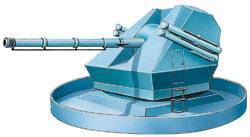 The latest Russian development is an automatic 130-mm artillery A-192E: firing range of at least 22 km, 30 firing rate / min, combat crew 3 people, mass without ammunition 25 °, pointing angles from –12 ° to 80 ° vertical and –170 ° to 170 ° horizontal
The latest Russian development is an automatic 130-mm artillery A-192E: firing range of at least 22 km, 30 firing rate / min, combat crew 3 people, mass without ammunition 25 °, pointing angles from –12 ° to 80 ° vertical and –170 ° to 170 ° horizontal Developers needed to solve a whole range of tasks in order for a new weapon to meet the basic requirements of admirals. In particular, the caliber was supposed to be about 25 — 30 millimeters, the gun had to be remotely controlled by an operator in a robust case, and had little recoil. In addition, the gun should have been able to shoot under water, at a periscope depth, and have high firing accuracy (for a submarine, low consumption of ammunition is a very important condition).
The project, designated “Moray”, suggested placing the 30-mm Mauser automatic cannon RMK 30х230 in a special container with a diameter of 0,8 meter located in the submarine felling fence and being advanced almost 4,5 meters by means of a lifting mast device. After that, the hydraulic-driven piston-cylinder “squeezed” the gun out of the container, and in a few moments it was ready to fire.
The uniqueness of the gun RMK 20x230, originally created for the European military helicopter "Tiger", is that it has no recoil and uses shots with a burning sleeve, in which the projectile is almost completely recessed. In addition, the gun - revolving type, has a drum for four shots, fed into the drum chamber not from behind, but from the front. This led to a substantial reduction in the breech of the weapon and, accordingly, reduced its total mass. Plus no-feed supply of ammunition, and to ensure the guidance of the gun and its loading uses a special electric drive. The rate of fire - 300 shots / min, shooting is carried out in bursts of 3 — 4 projectile. The shots have a special marking according to the type of projectile, which allows the shooter to quickly change ammunition, depending on the nature of the target.
Energy throw
And yet the powder shot is already yesterday, today at best. Tomorrow's day belongs to the ship's guns, created on completely different principles: in some, the projectile will be sent to the target with the power of an electromagnetic pulse, while in others the laser beam will play the role of the projectile.
What is the beauty of an electromagnetic gun, or, as it is called, railgun? Visually assess the potential power of such weapons can be quite simple: just take a disc with an American blockbuster "Eraser", where the hero of Arnold Schwarzenegger in Macedonian, with two hands, famously "wets" with the help of electromagnetic assault rifles of terrorists and traitors who were going to sell the party most of these Russian rifles (well, what else, one wonders) of the mafia. However, manual electromagnetic weapons are still a topic for science fiction writers, but a large electromagnetic gun soon, quite likely, will be able to press the powder artillery on the ship's deck.
The principle of railgun operation is as follows: a diesel generator charges a group of capacitors that, at the command of Fire!, Deliver current into millions of amps into the barrel on two parallel plate-rails, creating, in this way, a powerful magnetic field around them. The chain is closed with an insert, which is located directly behind the projectile and as if pushes it forward with a magnetic field.
The first test of the electromagnetic tool was conducted in January 2008 of the year: American designers managed to achieve record energy of a shot on the world's largest railgun - more than 10,64 MJ. It’s like the kinetic energy of a large dump truck loaded at speed 100 km / h and loaded to the eyeballs. And although it was only 33% of the maximum power of the gun, the three-kilogram shell was able to accelerate to the speed of 2,52 km / s!
When the engineers on the basis of this prototype build a real ship installation, she can throw a projectile with energy 64 MJ: the initial velocity of the projectile will be up to 6 km / s, and its speed at the moment of hitting the target will be about 1,7 km / s. The rate of fire of such a system can be from 6 to 12 bursts / min, and the maximum range to 250 miles, or about 460 kilometers (if the US Navy requires a range of at least 200 miles - 370 kilometers). This is 12 times as large as the American 127-mm Mk45 guns with the Dedalus missile and the Mk406 X-guns of the Iowa type battleships with a standard charge. Priority carrier for railgun - promising US destroyers and cruisers.
The second weapon is the ship's version of a laser gun, and more specifically, a family of laser combat complexes, including even a high-energy laser installation for submarines. However, only as a means of self-defense from small targets, aircraft and missiles. Replacing torpedoes and missiles on a submarine will not appear soon. Yes, and work on the laser gun for self-defense was actively pursued only after the terrorist attack on the American destroyer URO "Cole", which undermined the motor boat-brander (although the work on creating a laser to fight missiles was carried out since 1971, and the fleet was the first to create a megawatt laser class - MIRACL).
But now this topic is officially spelled out in the concept of developing advanced naval armaments systems “Strike from the sea”, and several years ago work began on integrating a high-energy laser into the Phalanx complex: the laser facility should replace the gun unit, and the energy block. Laser gun reload time - 10 seconds. A variant using a low-energy laser is also being developed to fight off anti-ship missiles equipped with homing heads.
It is quite probable that we will see railgun on superexjectors and laser cannon on submarines in 10 — 15 years.
Illustrations by Mikhail Dmitriev
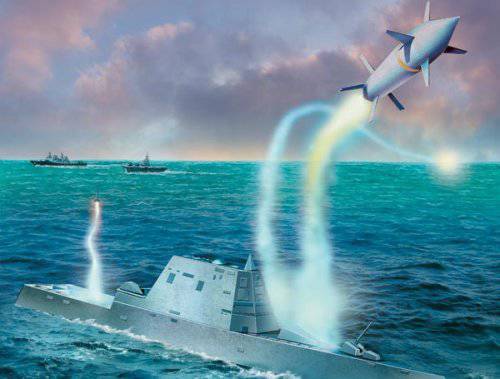
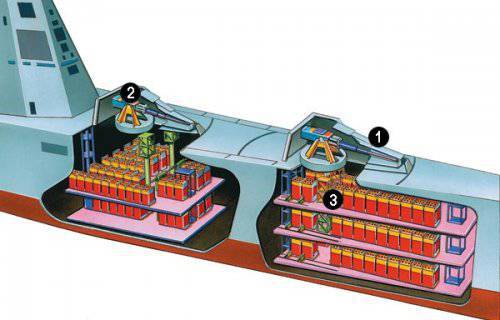
Information